Hypothetical portfolio
Introduction
Creating a Portfolio
Modify an existing Portfolio composition
Changes in allocation
Start date of the Portfolio series
The total value of the portfolio
Show values at the end of each day, week, month or year
Show amounts in percentages or values
Securities contributions to the Portfolio performance
Employ the portfolio module to combine the series of two securities
Create a portfolio whose performance is equal to an index plus a certain
percentage
The folder which holds the files of each portfolio
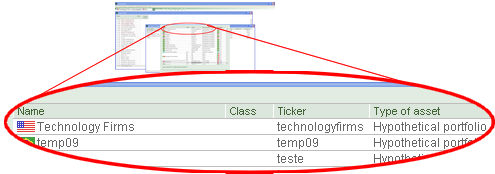 Introduction: The Hypothetical
portfolio module allows the user to choose a set of securities,
assign weights to each security and the system will create a historical
price serie for that portfolio. The portfolio will then become a member
of the list of securities in the system. In the example to the side, the
user created a portfolio called “Technology Firms”, and since the system
then treats this portfolio as any other security in the database, you
can then take advantage of all the resources in the system including:
graphs, highlights, technical indicators (Price change, volatility, etc),
use the portfolio as a benchmak, etc.
Introduction: The Hypothetical
portfolio module allows the user to choose a set of securities,
assign weights to each security and the system will create a historical
price serie for that portfolio. The portfolio will then become a member
of the list of securities in the system. In the example to the side, the
user created a portfolio called “Technology Firms”, and since the system
then treats this portfolio as any other security in the database, you
can then take advantage of all the resources in the system including:
graphs, highlights, technical indicators (Price change, volatility, etc),
use the portfolio as a benchmak, etc.
The
Type of asset assigned to hypothetical portfolios is Hypothetical
Portfolio
Any security available
in the Economatica database could be included in the hypothetical portfolios.
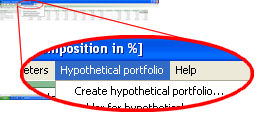 Creating a Portfolio: To create
a portfolio the user must open the Portfolio
Holdings module (to learn how to open a new module, consult chapter
Basic Structure > Getting started),
click the option Hypothetical Portfolio
and select Create Hypothetical portfolio
from the menu as shown on the side.
Creating a Portfolio: To create
a portfolio the user must open the Portfolio
Holdings module (to learn how to open a new module, consult chapter
Basic Structure > Getting started),
click the option Hypothetical Portfolio
and select Create Hypothetical portfolio
from the menu as shown on the side.
 In the next
screen, the user should enter the portfolio name. The system will automatically
create a portfolio code (based on its name), however, if the user wishes
the code
can be changed.
In the next
screen, the user should enter the portfolio name. The system will automatically
create a portfolio code (based on its name), however, if the user wishes
the code
can be changed.
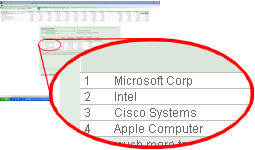 The user should
then create the list of securities that will comprise the portfolio. The
user can generate this list by pressing the <insert> key and picking
each security at a time. Aternatively, the user may also create a Stock
Guide with all the desired securities (consult chapter Stock
Guide > Filter), copy all the rows (ctrl C) in the Stock Guide
and then paste (ctrl V) into the portfolio editing screen.
The user should
then create the list of securities that will comprise the portfolio. The
user can generate this list by pressing the <insert> key and picking
each security at a time. Aternatively, the user may also create a Stock
Guide with all the desired securities (consult chapter Stock
Guide > Filter), copy all the rows (ctrl C) in the Stock Guide
and then paste (ctrl V) into the portfolio editing screen.
In the side example the
user chose the stocks of four technology companies for the portfolio.
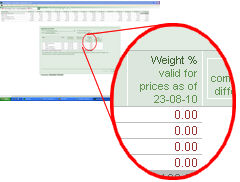 After selecting
the securities the user must then enter the weight of each in the column
indicated on the side image. The weights must be assigned in percentage
terms and therefore the total sum must be equal to 100%.
After selecting
the securities the user must then enter the weight of each in the column
indicated on the side image. The weights must be assigned in percentage
terms and therefore the total sum must be equal to 100%.
In cases in which the portfolio
consists of many securities, it is possible to copy (ctrl C) the weights
from an external source (in case there is one) and paste them (ctrl V)
into the weight column of the portfolio editing screen.
 The user must
also inform the date for which the weights correspond. This is necessary
because weights valid for a certain date will not be valid for a different
date as the prices of the various securities will change across time in
an ununiform manner.
The user must
also inform the date for which the weights correspond. This is necessary
because weights valid for a certain date will not be valid for a different
date as the prices of the various securities will change across time in
an ununiform manner.
By entering the weights
at a certain date the user is indirectly informing the number of shares
held in each security. In the case on the side, for example, entering
the weight as 60% for the shares of Microsoft in the portfolio on 23/08/2010
can be interpreted as if $60 were invested in shares of that company in
that date, and, as the share price of Microsoft on 23/08/2010 was $24.28,
we can interprete that the portfolio has 2.47 shares of Microsoft ( 2.47
= 60 / 24.28).
This number will remain
constant across time. The weights of each security however change since,
as previously indicated, the prices of each security change ununiformly.
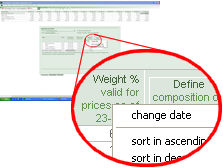 To inform
the reference date of the weights entered the user must click the mouse
right button over the weight column header and choose Change
Date from the menu.
To inform
the reference date of the weights entered the user must click the mouse
right button over the weight column header and choose Change
Date from the menu.
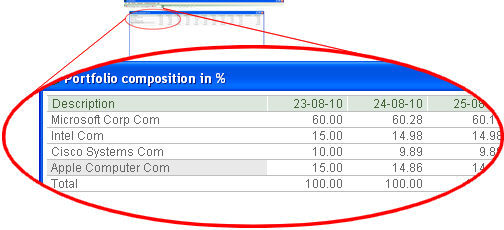 Once the user
selects the Save option in the editing
window (where the securities were selected and their weights entered)
a window will appear with the values of the portfolio day by day. In the
final topics of this chapter alternative options of displaying these values
will be described.
Once the user
selects the Save option in the editing
window (where the securities were selected and their weights entered)
a window will appear with the values of the portfolio day by day. In the
final topics of this chapter alternative options of displaying these values
will be described.
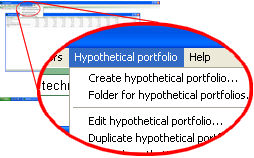 Modify an existing portfolio composition:
Follow the next steps to modify an existing portfolio composition:
Modify an existing portfolio composition:
Follow the next steps to modify an existing portfolio composition:
- a portfolio
holdings window must be open and must be the active window
- the portfolio being modified must be the Current
company (see chapter Basic Structure>
Change company)
- click Hypothetical Portfolio and
choose Edit hypothetical portfolio
from the menú (side image)
Changes in allocation: As
we have seen, by defining the composition on a given date, the user is
indirectly defining the number of shares held in each security, which
is a number that remains constant. The user, however, can make changes
to the number of shares held, in other words, define multiple compositions
in different dates so that the number of shares is constant only through
the date of the next composition.
Starting from the date of the new composition, new number of shares become
valid until the date of the next composition defined by the user and so
on.
Changes in shares held
are done without adding or taking out investments from the portfolio,
in other words, defining a new composition on date D, occurs as if all
of the securities in the old composition were sold (at the closing price
of date D) and the proceeds from the sale (neither more nor less) are
then used to acquire the new securities defined in the new composition
(bought also at the closing price of date D)
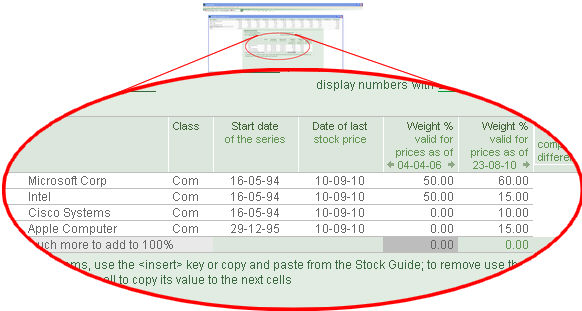 The oldest
composition defined by the user has a special treatment: in addition to
it being valid until the date of the next composition, it is also valid
going into the past. In the example to the side, the numbers defined as
of 04/04/2006 are valid from the beginning of the portfolio (see topic
Start date of the portfolio series
below) to the date of the next composition defined on 23/08/2010.
The oldest
composition defined by the user has a special treatment: in addition to
it being valid until the date of the next composition, it is also valid
going into the past. In the example to the side, the numbers defined as
of 04/04/2006 are valid from the beginning of the portfolio (see topic
Start date of the portfolio series
below) to the date of the next composition defined on 23/08/2010.
When there is only one
composition the numbers defined are valid from the start date of the portolio
to the end.
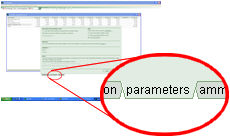 Start date of the portfolio series:
The user can choose the start date of the portfolio. After defining the
weight for each security click on tab Parameters
(as shown to the side).
Start date of the portfolio series:
The user can choose the start date of the portfolio. After defining the
weight for each security click on tab Parameters
(as shown to the side).
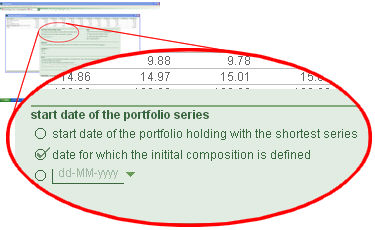 In the window
that will appear (side image) the user specifies the start date of the
portfolio series by selecting one of the options presented as illustrated
on the side.
In the window
that will appear (side image) the user specifies the start date of the
portfolio series by selecting one of the options presented as illustrated
on the side.
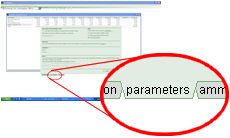 The total value of the portfolio: Even
though the user defines the portfolio composition by entering percentage
weight of each security, the system allows the user to enter the value
of the portfolio. This is done by clicking on the tab Parameters
as depicted on the side image.
The total value of the portfolio: Even
though the user defines the portfolio composition by entering percentage
weight of each security, the system allows the user to enter the value
of the portfolio. This is done by clicking on the tab Parameters
as depicted on the side image.
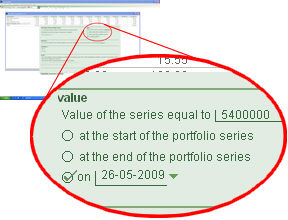 In the window
that will appear (side image) the user specifies the value of the portfolio
by selecting one of the options presented as illustrated on the side.
In the adjacent example, the user informed that the total investment value
of the portfolio on 26/05/2009 was $5,400,000.
In the window
that will appear (side image) the user specifies the value of the portfolio
by selecting one of the options presented as illustrated on the side.
In the adjacent example, the user informed that the total investment value
of the portfolio on 26/05/2009 was $5,400,000.
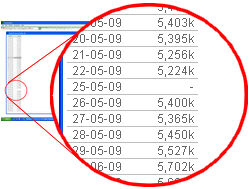 As can be
seen in the adjacent image (Stock
Prices window), the entire portfolio
series will be compatible with the investment value informed by the user.
As can be
seen in the adjacent image (Stock
Prices window), the entire portfolio
series will be compatible with the investment value informed by the user.
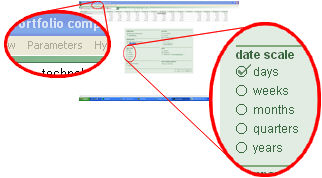 Show values at the end of each day,
week, month or year: Clicking the option Parameters
(shown on the side) brings up the parameters window which provides the
user the option to show the portfolio composition daily or at the end
of each week, month, quarter or year
Show values at the end of each day,
week, month or year: Clicking the option Parameters
(shown on the side) brings up the parameters window which provides the
user the option to show the portfolio composition daily or at the end
of each week, month, quarter or year
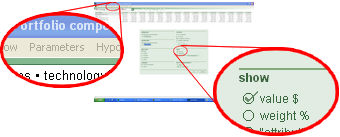 Show amounts in percentages or values:
Clicking the option Parameters (shown
on the side) brings up the parameters window which provides the user the
option of whether to view each security holding according to its percentage
weight or investment value.
Show amounts in percentages or values:
Clicking the option Parameters (shown
on the side) brings up the parameters window which provides the user the
option of whether to view each security holding according to its percentage
weight or investment value.
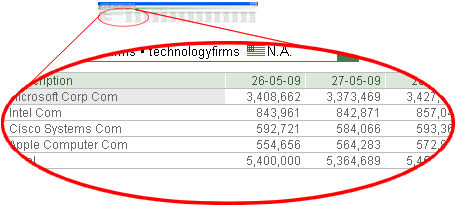 The investment
value of each security is a result of the definitions made by the user
as described in topic The total value of
the portfolio above. The side image shows investment values of
a portfolio whose value was assigned by the user to be $5,400,00 on 26-May-2009
The investment
value of each security is a result of the definitions made by the user
as described in topic The total value of
the portfolio above. The side image shows investment values of
a portfolio whose value was assigned by the user to be $5,400,00 on 26-May-2009
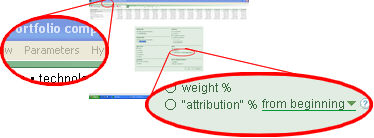 Securities contribution to the portfolio
performance: In addition to viewing the weight percentage or the
investment value in each security, it is also possible to see the performance
contribution of each security to the overall portfolio performance. The
contributions of each security depend on their individual return and weight
in the portfolio. To show contributions, the user must click on the option
Parameters (shown on the side), and
then choose the option Attribution %
in the parameters window as shown on the side image.
Securities contribution to the portfolio
performance: In addition to viewing the weight percentage or the
investment value in each security, it is also possible to see the performance
contribution of each security to the overall portfolio performance. The
contributions of each security depend on their individual return and weight
in the portfolio. To show contributions, the user must click on the option
Parameters (shown on the side), and
then choose the option Attribution %
in the parameters window as shown on the side image.
By clicking on the arrow
found in the right hand side of from beginning
the user reaches a window that provides the option to choose the period
for which to view the contributions.
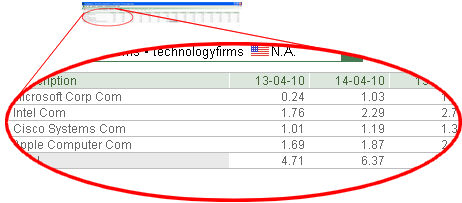 The image
to the side shows a hypothetical portfolio whose start date was defined
by the user as 31/12/2009. The user chose to view the contribution of
each security since the start date.
The image
to the side shows a hypothetical portfolio whose start date was defined
by the user as 31/12/2009. The user chose to view the contribution of
each security since the start date.
In this case, from the
start date until 13/04/2010, the portfolio returned 4.71%, that is, for
every $100 the portfolio earned $4.71, broken down as follows:
- 0.24 was earned from
the return produced by the shares of Microsoft in the portfolio
- 1.76 was earned from the return produced by the shares of Intel in the
portfolio
- 1.01 was earned from the return produced by the shares of Cisco in the
portfolio
- 1.69 was earned from the return produced by the shares of Apple in the
portfolio
Naturally, the contribution
of each security does not account for increases or decreases caused by
changes in allocation done by the user (see topic Changes
in allocation above)
Employ the portfolio module to combine the series of two
securities: There are cases in which a certain security is cancelled
and holders receive a different security in exchange. In such cases the
investor typically wishes to see historical prices which combine the old
security prices with the new security prices. The Hypothetical
portfolio module can be used for this purpose as explained below.
This combined series would
be the value of a portfolio that has 100% in the old security until the
date of the exchange and then 100% of the new security from that point
forward. Though the steps described earlier in this chapter can be used
to construct a portfolio with these specifications, the system offers
a simpler and quicker option to achieve this purpose of combining series.
Below we describe this alternative.
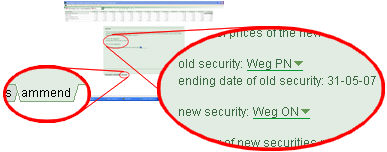 The user should
create a new portfolio following the steps discussed earlier, but after
providing the portfolio name the user should not insert any security into
the list of items in the portfolio. Rather, the user should click on tab
Ammend as shown in the side image.
The user should
create a new portfolio following the steps discussed earlier, but after
providing the portfolio name the user should not insert any security into
the list of items in the portfolio. Rather, the user should click on tab
Ammend as shown in the side image.
In the Ammend
window (side image), the user should simply specify the name of the old
security, the name of the new security and the exchange ratio. In the
example to the side, the security Weg PN ceased to exist on 31/05/2007
and its holders received in exchange the security Weg ON.
The investment value of
the portfolio constructed with the Ammend
tool is not defined the same way described in topic The
investment value of the portfolio above. Rather the investment
value of ammended series coincide with the value of the new security.
Create a portfolio whose performance is equal to an index
plus a certain percentage: The hypothetical
portfolio module allows the user to create a portfolio whose performance
is equal to an index (selected by the user) plus a certain percentage
amount (specified by the user). These types of series are frequently necessary
to be used as benchmarks.
 To create
a portfolio with this characteristic the user should follow the steps
described earlier and create a portfolio where the desired index weight
represents 100 % the portfolio. In the example to the side, the portfolio
is comprised 100% by the inflation index of the US (CPI).
To create
a portfolio with this characteristic the user should follow the steps
described earlier and create a portfolio where the desired index weight
represents 100 % the portfolio. In the example to the side, the portfolio
is comprised 100% by the inflation index of the US (CPI).
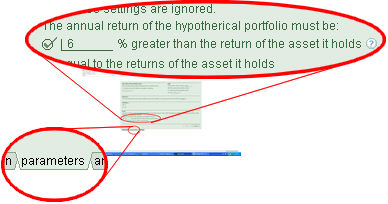 The user should
then click the tab Parameters (shown
on the side) and in the window that comes up enter the annual percentage
amount that the portfolio should return over the annual return of the
index. In
the example to the side, the user specified this amount as 6%. This means
that in a year in which the CPI returns 5%, the portfolio should return
11.3% (1.113 = 1.05 * 1.06).
The user should
then click the tab Parameters (shown
on the side) and in the window that comes up enter the annual percentage
amount that the portfolio should return over the annual return of the
index. In
the example to the side, the user specified this amount as 6%. This means
that in a year in which the CPI returns 5%, the portfolio should return
11.3% (1.113 = 1.05 * 1.06).
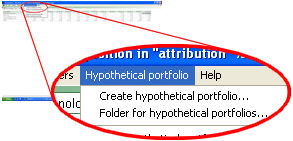 The folder which holds the files of each
portfolio: As explained earlier, the hypothetical portfolios created
by the user become part of the list of securities in the system’s database.
The folder which holds the files of each
portfolio: As explained earlier, the hypothetical portfolios created
by the user become part of the list of securities in the system’s database.
Each hypothetical portfolio
created by the user is saved in a file with extensión PTF. The portfolios
that are added to the list of securities in the system are those whose
files are located in the system’s portfolio folder. This system’s portfolio
folder can be viewed or changed by clicking the option
Hypothetical portfolio and choosing
Folder for hypothetical portfolios from the menu.
 Introduction: The Hypothetical
portfolio module allows the user to choose a set of securities,
assign weights to each security and the system will create a historical
price serie for that portfolio. The portfolio will then become a member
of the list of securities in the system. In the example to the side, the
user created a portfolio called “Technology Firms”, and since the system
then treats this portfolio as any other security in the database, you
can then take advantage of all the resources in the system including:
graphs, highlights, technical indicators (Price change, volatility, etc),
use the portfolio as a benchmak, etc.
Introduction: The Hypothetical
portfolio module allows the user to choose a set of securities,
assign weights to each security and the system will create a historical
price serie for that portfolio. The portfolio will then become a member
of the list of securities in the system. In the example to the side, the
user created a portfolio called “Technology Firms”, and since the system
then treats this portfolio as any other security in the database, you
can then take advantage of all the resources in the system including:
graphs, highlights, technical indicators (Price change, volatility, etc),
use the portfolio as a benchmak, etc.
 In the next
screen, the user should enter the portfolio name. The system will automatically
create a portfolio code (based on its name), however, if the user wishes
the code
can be changed.
In the next
screen, the user should enter the portfolio name. The system will automatically
create a portfolio code (based on its name), however, if the user wishes
the code
can be changed. The user should
then create the list of securities that will comprise the portfolio. The
user can generate this list by pressing the <insert> key and picking
each security at a time. Aternatively, the user may also create a Stock
Guide with all the desired securities (consult chapter
The user should
then create the list of securities that will comprise the portfolio. The
user can generate this list by pressing the <insert> key and picking
each security at a time. Aternatively, the user may also create a Stock
Guide with all the desired securities (consult chapter  After selecting
the securities the user must then enter the weight of each in the column
indicated on the side image. The weights must be assigned in percentage
terms and therefore the total sum must be equal to 100%.
After selecting
the securities the user must then enter the weight of each in the column
indicated on the side image. The weights must be assigned in percentage
terms and therefore the total sum must be equal to 100%. The user must
also inform the date for which the weights correspond. This is necessary
because weights valid for a certain date will not be valid for a different
date as the prices of the various securities will change across time in
an ununiform manner.
The user must
also inform the date for which the weights correspond. This is necessary
because weights valid for a certain date will not be valid for a different
date as the prices of the various securities will change across time in
an ununiform manner. To inform
the reference date of the weights entered the user must click the mouse
right button over the weight column header and choose
To inform
the reference date of the weights entered the user must click the mouse
right button over the weight column header and choose  Once the user
selects the
Once the user
selects the 
 The oldest
composition defined by the user has a special treatment: in addition to
it being valid until the date of the next composition, it is also valid
going into the past. In the example to the side, the numbers defined as
of 04/04/2006 are valid from the beginning of the portfolio (see topic
The oldest
composition defined by the user has a special treatment: in addition to
it being valid until the date of the next composition, it is also valid
going into the past. In the example to the side, the numbers defined as
of 04/04/2006 are valid from the beginning of the portfolio (see topic

 In the window
that will appear (side image) the user specifies the start date of the
portfolio series by selecting one of the options presented as illustrated
on the side.
In the window
that will appear (side image) the user specifies the start date of the
portfolio series by selecting one of the options presented as illustrated
on the side.
 In the window
that will appear (side image) the user specifies the value of the portfolio
by selecting one of the options presented as illustrated on the side.
In the adjacent example, the user informed that the total investment value
of the portfolio on 26/05/2009 was $5,400,000.
In the window
that will appear (side image) the user specifies the value of the portfolio
by selecting one of the options presented as illustrated on the side.
In the adjacent example, the user informed that the total investment value
of the portfolio on 26/05/2009 was $5,400,000. As can be
seen in the adjacent image (
As can be
seen in the adjacent image (

 The investment
value of each security is a result of the definitions made by the user
as described in topic
The investment
value of each security is a result of the definitions made by the user
as described in topic 
 The image
to the side shows a hypothetical portfolio whose start date was defined
by the user as 31/12/2009. The user chose to view the contribution of
each security since the start date.
The image
to the side shows a hypothetical portfolio whose start date was defined
by the user as 31/12/2009. The user chose to view the contribution of
each security since the start date. The user should
create a new portfolio following the steps discussed earlier, but after
providing the portfolio name the user should not insert any security into
the list of items in the portfolio. Rather, the user should click on tab
The user should
create a new portfolio following the steps discussed earlier, but after
providing the portfolio name the user should not insert any security into
the list of items in the portfolio. Rather, the user should click on tab
 To create
a portfolio with this characteristic the user should follow the steps
described earlier and create a portfolio where the desired index weight
represents 100 % the portfolio. In the example to the side, the portfolio
is comprised 100% by the inflation index of the US (CPI).
To create
a portfolio with this characteristic the user should follow the steps
described earlier and create a portfolio where the desired index weight
represents 100 % the portfolio. In the example to the side, the portfolio
is comprised 100% by the inflation index of the US (CPI). The user should
then click the tab
The user should
then click the tab 